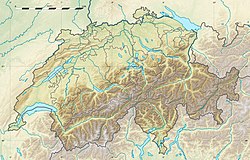
Saint Thomas Church is an Episcopal parish church of the Episcopal Diocese of New York at 53rd Street and Fifth Avenue in Midtown Manhattan, New York City. Also known as Saint Thomas Church Fifth Avenue or Saint Thomas Church in the City of New York, the parish was incorporated on January 9, 1824. The current structure, the congregation's fourth church, was designed by the architects Ralph Adams Cram and Bertram Grosvenor Goodhue in the French High Gothic Revival style and completed in 1914. In 2021, it reported 2,852 members, average in-person attendance of 224 and $1,152,588 in plate and pledge income.
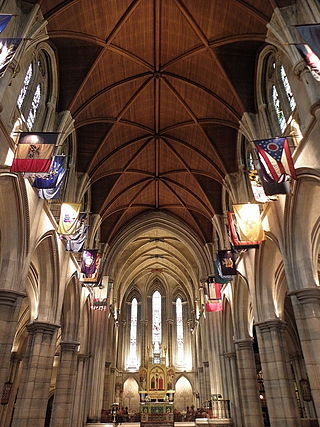
The American Cathedral in Paris, formally known as the Cathedral Church of the Holy Trinity, is one of the oldest English-speaking churches in Paris. It is the gathering church for the Convocation of Episcopal Churches in Europe, and is part of the worldwide Anglican Communion. The church is located in central Paris between the Champs-Elysées and the River Seine at 23 avenue George V in the 8th arrondissement. The closest métro stations are Alma – Marceau and George V .
The Convocation of Episcopal Churches in Europe is a jurisdiction of the United States-based Episcopal Church created in 1859 by an action of its general convention. The convocation includes all Episcopal congregations in continental Europe. Along with dioceses in New York, New Jersey, Haiti, Cuba, and the Virgin Islands it belongs to Province II of the Episcopal Church.

The Cathedral Church of the Advent in Birmingham, Alabama, is the see church of the Episcopal Diocese of Alabama. On March 30, 1983, the structure was added to the National Register of Historic Places as the Episcopal Church of the Advent.
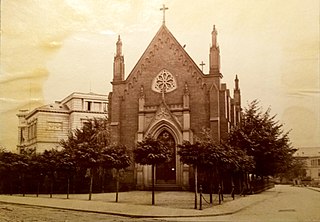
The Church of St Augustine of Canterbury, commonly known as The English church at Wiesbaden, is a Hessian heritage-listed Anglican parish church located at Frankfurter Strasse 3 in Wiesbaden, Germany. Built in 1865 and named in honour of St Augustine of Canterbury, it was designed in the Gothic Revival style by city engineer Theodor Goetz. The church remains historically, socially, and architecturally significant.
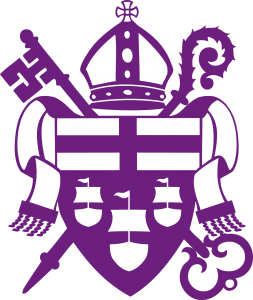
The Diocese of Virginia is the largest diocese of the Episcopal Church in the United States of America, encompassing 38 counties in the northern and central parts of the state of Virginia. The diocese was organized in 1785 and is one of the Episcopal Church's nine original dioceses, with origins in colonial Virginia. As of 2018, the diocese has 16 regions with 68,902 members and 180 congregations.

St. John's Episcopal Church, named after St. John the Evangelist, is an historic church building located at 609 South Main Street, Moultrie, Georgia, United States. Originally an Episcopal church in the Diocese of Georgia, it is now known as St. Mark's Anglican Church and continues to follow the Anglo-Catholic tradition of worship, but now belongs to the Anglican Church in North America and is a Forward in Faith parish. St. Mark's uses the 2019 Book of Common Prayer (ACNA) and 1940 Hymnal for all services. It is one of the oldest Christian churches in Colquitt County.
St. John's Episcopal Church is a historic Episcopal church located at 61 Broad Street in the historic heart of Elizabeth, New Jersey. Now part of the Episcopal Diocese of New Jersey headquartered in Trenton, it was founded in 1706 by missionaries of the Society for the Propagation of the Gospel, London, England. The current building, consecrated in 1860, is in the neo-Gothic style, with a 126-foot Gothic style tower.
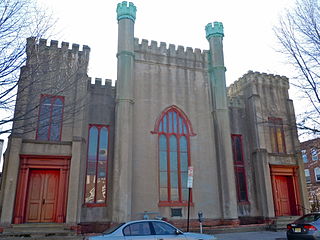
Established in 1703, St. Michael's Church in downtown Trenton, Mercer County, New Jersey, United States, is a founding parish of the Episcopal Diocese of New Jersey. Its present building located at 140 North Warren Street was built in 1747–1748, and was renovated in 1810 and 1847–1848. It was listed on the National Register of Historic Places on April 29, 1982 as St. Michael's Episcopal Church.

The Falls Church is an historic Episcopal church, from which the city of Falls Church, Virginia, near Washington, D.C., takes its name. Established in 1732, the parish in 1769 built a brick church building that remains in use today.

Chapel of the Cross is a parish of the Episcopal Church of the United States in Chapel Hill in the Diocese of North Carolina. It is the spiritual home to more than 1,600 communicants, including numerous students studying at the University of North Carolina at Chapel Hill.

Christ Church — known also as Christ Church, Washington Parish or Christ Church on Capitol Hill — is a historic Episcopal church located at 620 G Street SE in Washington, D.C., USA. The church is also called Christ Church, Navy Yard, because of its proximity to the Washington Navy Yard and the nearby U.S. Marine Barracks.

Christ Church, founded in 1705, is a historic Episcopal parish located at 61 East Main Street in Oyster Bay, New York. Several church buildings have occupied this site, including one that served as soldiers' barracks during the Revolutionary War.

The Falls Church Anglican is an Anglican parish in the Falls Church section of Fairfax County, Virginia, near Washington, D.C. In 2006, the congregation of The Falls Church divided over the question of whether to leave the Episcopal Church, effectively creating two congregations: The Falls Church Anglican and The Falls Church.

Old Donation Church is the third Lynnhaven Parish Church and is the oldest church in Virginia Beach. Records show that the parish's first church services were held in 1637 in the home of Adam Thoroughgood. The first church building was constructed on Mr. Thoroughgood's land in 1639 on the location later known as "Church Point." The vestry, or governing body of the church, was established in 1640.

St. James Church is a historic Episcopal church building at 86-02 Broadway in the Elmhurst neighborhood of Queens in New York City. It is the city's oldest surviving Anglican building and Church of England mission church. It is also alternatively called the Old St. James Church to distinguish it from the St. James Episcopal Church two blocks away.

Christ Church, also known as Christ Episcopal Church, is a Christian house of worship located on the corner of Church Street and Main Street in Newton, New Jersey. It is a parish overseen by the Episcopal Diocese of Newark, a diocese of the Episcopal Church in the United States of America. The congregation first met on 28 December 1769 and was granted a charter by New Jersey's last Royal Governor William Franklin on behalf of Britain's King George III. Christ Church is the oldest church in Newton and the third oldest parish in the Diocese of Newark.
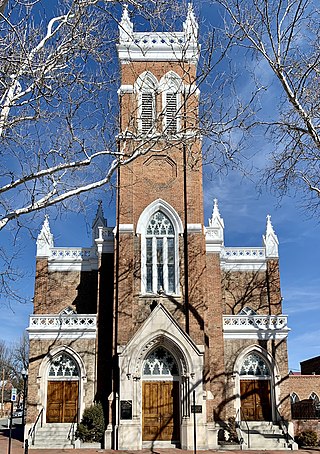
Christ Church, or Christ Episcopal Church, is an Anglican church in Winchester, Frederick County, Virginia. The church was founded in 1738, with its first vestry elected in 1742. It is the seat of Frederick Parish, Diocese of Virginia, which once covered half of the Shenandoah valley and western Virginia, including what became West Virginia. The current church building, the parish's third, was designed by Robert Mills - it was completed in 1828, and is the oldest church building continuously used for religious purposes in the county. It is a contributing building in the local Historic District which predates the National Register of Historic Places, and which has been expanded three times since 1980.

Christ Church Accokeek is an Anglican parish church and cemetery in Accokeek, Maryland. Founded in 1698 as a chapel of ease, the present brick structure dates to 1747 and the cemetery to 1775. In 2021, after decades of conflict with the Episcopal Diocese of Washington, the congregation left the Episcopal Church and joined the Anglican Church in North America. The church is listed on the Maryland Historical Trust's Maryland Inventory of Historic Properties.

The Church of Our Saviour at Oatlands is a Reformed Episcopal parish located south of Leesburg, Virginia. Founded in 1871 as a parish of the Episcopal Diocese of Virginia, it met for most of its history in a historic church building on the grounds of the Oatlands plantation. The congregation elected to leave the Episcopal Church during the Anglican realignment and in 2016 relocated to a new building a mile north of the original historic church. It is noted for its use of the 1928 Book of Common Prayer.

